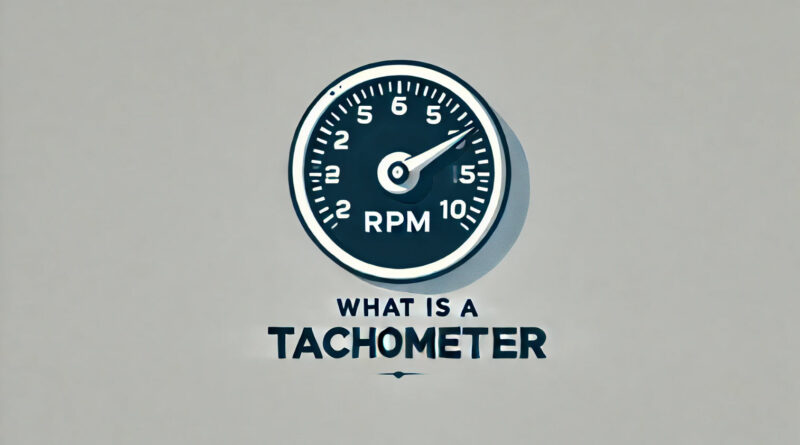What Is a Tachometer, and Why Does It Matter?
Let’s break down what a tachometer does, how it works, and why it’s useful for everyday driving. If you’ve ever noticed the gauge on your car’s dashboard with the label “RPM” or “Tachometer,” you might have wondered what it’s all about. Simply put, the tachometer measures how fast your car’s engine is spinning. It’s a handy tool that gives you insight into how hard your engine is working, helping you drive more efficiently and take better care of your vehicle.
Let’s break down what it does, how it works, and why it’s useful for everyday driving.
What Exactly Is a Tachometer?
It’s a device that shows your engine’s revolutions per minute (RPM). In simple terms, it tells you how many times the engine’s crankshaft spins in one minute.
You’ll find it on your dashboard, usually as a circular gauge next to the speedometer. The numbers on the tachometer represent thousands of RPMs, so if the needle is pointing to “3,” your engine is spinning at 3,000 revolutions per minute.
How Does a Tachometer Work?
Here’s how it works:
- It Monitors Engine Speed: Sensors in your car detect how fast the engine is spinning.
- Displays RPM: Converts this data into a visual display, either as a needle moving across the gauge or as numbers on a digital screen.
- Adjusts in Real-Time: As you press the accelerator, the engine spins faster, and the more needle rises. When you slow down, it drops back.
That’s it! It’s a straightforward tool that works silently to keep you informed about your engine’s activity.
Why Is a Tachometer Important?
You might wonder if the tachometer is just there for looks, but it’s much more than that. Here’s why it matters:
1. Protects Your Engine
The tachometer helps you avoid pushing your engine too hard. If the needle enters the “red zone,” it means the RPM is too high, and you risk overheating or damaging your engine.
2. Saves Fuel
Driving at an optimal RPM helps your engine work more efficiently, which can save you fuel.
3. Makes Gear Shifting Easier
If you drive a manual car, the tachometer is your best friend. It tells you when to shift gears for a smoother drive and less wear on your car.
4. Alerts You to Problems
If your engine’s RPM is behaving oddly—like jumping up and down or staying unusually high—it could signal a problem that needs attention.
Who Really Needs a Tachometer?
While every driver can benefit from a tachometer, it’s especially useful for:
- Manual Transmission Drivers: It helps you time your gear shifts perfectly.
- Performance Enthusiasts: If you love spirited driving, a tachometer helps you get the most out of your engine.
- DIY Mechanics: It’s a great tool for diagnosing engine issues.
- Heavy-Duty Drivers: People driving trucks or towing trailers can use the tachometer to ensure they’re not overworking the engine.
What About Electric Cars?
Good question! Electric vehicles (EVs) don’t typically have tachometers. Since EVs don’t rely on an engine with a crankshaft, there’s no need to measure RPM. Instead, their dashboards display other useful info like battery charge or power output.
Tachometer vs. Speedometer: What’s the Difference?
While the tachometer and speedometer might look similar, they measure two completely different things:
| Tachometer | Speedometer |
|---|---|
| What It Measures: Engine speed in RPM | Vehicle speed in miles or kilometers per hour |
| Purpose: Monitors engine performance | Tells you how fast you’re driving |
| Units: Thousands of RPM | MPH or km/h |
Common Issues with Tachometers
Like any car part, the tachometer can occasionally act up. Here are some common problems to watch for:
- Inaccurate Readings: The needle might show false RPM due to faulty sensors or wiring issues.
- Needle Stuck or Unresponsive: This could mean there’s a problem with the tachometer or its connection.
- Flickering or Erratic Behavior: Often caused by electrical interference or worn-out parts.
If you notice these issues, it’s worth having your car checked by a mechanic.
Tips for Keeping Your Tachometer in Good Shape
Taking care of your tachometer is simple:
- Check the Wiring: Make sure there are no loose or damaged connections.
- Keep an Eye on Performance: If you notice unusual RPM behavior, get it inspected.
- Follow Maintenance Schedules: Regular car servicing can help prevent issues before they start.
Why You Should Pay Attention to Your Tachometer
Even if you’re not a car enthusiast, the tachometer is a helpful tool that can improve your driving. It helps you shift gears smoothly, protect your engine, and even save fuel. Plus, it gives you a heads-up if something isn’t right under the hood.
Final Thoughts
A tachometer might seem like a small detail on your dashboard, but it plays a big role in keeping your car running smoothly. Whether you’re shifting gears in a manual car or just keeping an eye on your engine’s performance, the tachometer gives you valuable insights.
So, the next time you see that needle climbing or falling, you’ll know exactly what it’s telling you—and how to use it to be a smarter, more efficient driver!
Buying a used VW. Buying used vauxhall, BMW, Jaguar, Ford, Volvo, Range rover, Bentley, Aston Martin, Porsche, Ferrari, Lamborghini, Maserati, Hyundai, Tesla, Honda, Pagani

